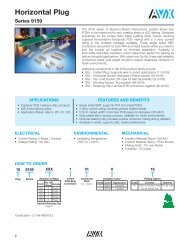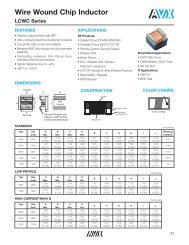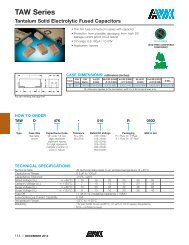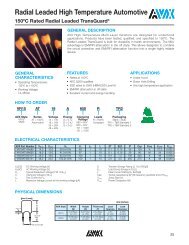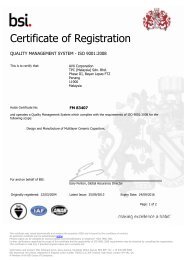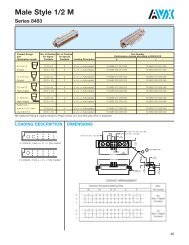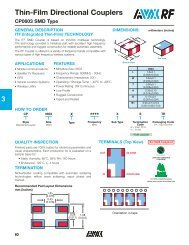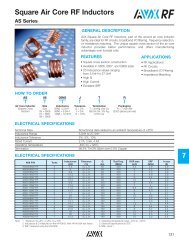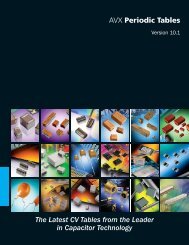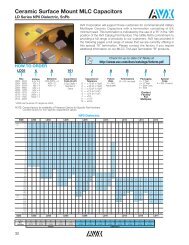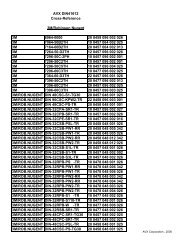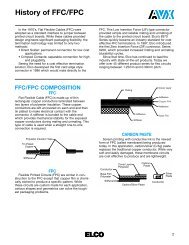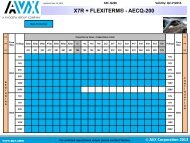TECHNICAL INFORMATION - AVX
TECHNICAL INFORMATION - AVX
TECHNICAL INFORMATION - AVX
Create successful ePaper yourself
Turn your PDF publications into a flip-book with our unique Google optimized e-Paper software.
TABLE 3<br />
THERMAL SHOCK STUDIES OF 1206 SIZE CHIPS<br />
WITH Pd/Ag TERMINATION<br />
OVERALL CHIP THICKNESS 33 (0.85) 45 (1.15)<br />
IN MILS (mm)<br />
NO. OF ELECTRODES WITH 0 2 4 8 16 24 NO .0 24 NO<br />
NO BRIDGE COVER COVER<br />
LAYERS LAYERS<br />
GREEN SOLDER DIP TEST RESULTS<br />
DIELECT. AT 425°C (800°F), NO PREHEAT<br />
ELECT. THICK. (Number of units with visual cracks in percent)<br />
CERA- THICK. IN MILS<br />
MIC (m) (m)<br />
A 3.3 1.6 (41) 0 0 0 0 0 0 0 0 0 0<br />
3.0 (76) 0 0 0 0 0 0 0 0 0 0<br />
5.5 1.6 (41) 0 0 0 0 0 0 0 0 0 0<br />
3.0 (76) 0 0 0 0 0 0 0 0 0 0<br />
B 5.5 3.0 (76) 0 0 0 0 0 0 0 0 0 0<br />
C 3.3 1.6 (41) 0 21 1 1 0 0 0 0 0 3<br />
2.4 (61) 0 33 2 0 0 0 0 0 0 0<br />
5.5 1.6 (41) 0 9 0 0 0 0 0 0 0 0<br />
2.4 (61) 0 6 0 0 0 0 0 0 0 0<br />
D 3.3 1.4 (36) 6 41 20 5 2 0 0 4 3 2<br />
E 3.3 1.4 (36) 0 0 0 3 90 0 0 0 96 3<br />
F 3.3 1.5 (38) 1 0 1 6 12 9 0 0 17 0<br />
1. NP0 Chips (Ceramics A and B) have excellent<br />
thermal shock resistance with none of the units<br />
showing any visual cracks. This is attributed to<br />
their relatively higher critical stress intensity<br />
factors of about 1.4 MPam 1/2 which prevents crack<br />
initiation and to the two phase pyrochlore<br />
microstructure of these materials which slows<br />
crack propagation as evidenced by the partial<br />
intergranular nature of the fracture along with<br />
various crack deflection sites in these ceramics. 3<br />
Ceramic A also has minor additives added as<br />
fluxes which form additional grain boundary and<br />
other phases which in turn further slow down<br />
the crack propagation. These aspects will be<br />
discussed further in our next paper.<br />
2. X7R Materials (Ceramics C and D) show an<br />
anomalous behavior where the ceramic itself<br />
exhibits no cracks and parts with high number of<br />
electrodes show no visual cracks. However, parts<br />
made with 2 to 16 electrodes develop many visual<br />
cracks with a 3.3m electrode thickness, and<br />
fewer with a 5.5m electrode thickness. This<br />
behavior is not exhibited by ceramic E in the<br />
same table, even though this is an X7R material<br />
as well. The behavior of ceramics C and D is<br />
characteristic of X7R materials prepared with<br />
minor fluxing additives which contain bismuth.<br />
Pd is known to diffuse into the ceramic and the<br />
remaining electrode is richer in Ag which in turn<br />
results in formation of Bi-Ag-Pd based alloys<br />
leaving porous electrodes. The corresponding<br />
ceramic cavities act as crack initiation sites<br />
resulting in thermal shock failures. This problem<br />
can be minimized by higher density modified<br />
electrodes and practically eliminated by the<br />
bridge designs discussed below.<br />
3. Ceramics E and F show higher number of visual<br />
cracks with high active MLCs. These are<br />
attributed to physical flaws which are discussed<br />
later.<br />
B. Design Considerations<br />
It was just demonstrated that X7R parts with<br />
2-16 electrodes with no bridge show a significant<br />
number of visual cracks. Chips (size 1206) with<br />
2-16 electrodes with a “bridge” are tested under<br />
TABLE 4<br />
THERMAL SHOCK STUDIES OF 1206 SIZE CHIPS WITH BRIDGE DESIGN<br />
AND Pd/Ag TERMINATION<br />
OVERALL CHIP THICKNESS 33 (0.85)<br />
IN MILS (mm)<br />
NO. OF ELECTRODES 0 2 4 8 16<br />
WITH A BRIDGE<br />
CERAMIC GREEN SOLDER DIP TEST RESULTS AT 425°C<br />
DIELECTRIC (800°F), NO PREHEAT (NUMBER OF<br />
THICKNESS IN UNITS WITH VISUAL CRACKS IN<br />
MILS (m) PERCENT)<br />
A 1.6 (41) 0 0 0 0 0<br />
3.0 (76) 0 0 0 0 0<br />
C 1.5 (38) 0 0 0 0 0<br />
2.4 (61) 0 0 0 0 0<br />
similar conditions and Table 4 shows that NP0 parts<br />
once again show excellent thermal shock resistance<br />
while X7R parts show a dramatic improvement.<br />
The improvement is attributed to the reduction of<br />
temperature gradients and corresponding stress<br />
gradients in these chips due to a relatively higher<br />
effective thermal conductivity near the surface of<br />
these chips because of the presence of electrodes.<br />
This aspect will be evaluated further in section (D)<br />
below.<br />
To evaluate the bridge design further, 1210 X7R<br />
0.1F parts are tested with and without a bridge<br />
and similar overall chip thickness, and these results<br />
are shown in Table 5; the parts with a bridge definitely<br />
show an improvement with lower number of<br />
visual cracks in the solder dip test. The overall chip<br />
thickness can be used to further improve the parts<br />
and this is discussed in the next section.<br />
TABLE 5<br />
THERMAL SHOCK STUDIES OF CERAMIC AS AFFECTED BY DESIGN<br />
OF CHIP 1210 X7R 0.1F, PLATED<br />
OVERALL CHIP THICKNESS 33 46 46<br />
IN MILS (mm) (0.85) (1.17) (1.17)<br />
SOLDER DIP TEST RESULTS AT 260°C<br />
(500°F), NO PREHEAT<br />
CHIP DESIGN 25A/35T* 25A/48T 25A/48T<br />
NO BRIDGE BRIDGE NO BRIDGE<br />
DESIGN<br />
LOT #<br />
1 6 21 63<br />
2 5 15 22<br />
3 7 13 31<br />
4 12 18 30<br />
5 2 11 20<br />
X = 6.4 15.6 33.2<br />
*A STANDS FOR ACTIVE LAYERS, T IS THE TOTAL NUMBER OF<br />
CERAMIC LAYERS<br />
C. Effect of Chip Thickness<br />
As discussed in the theoretical section of this<br />
paper, thermal stresses depend on the square of the<br />
overall chip thickness; therefore, this parameter is<br />
very important in the chip design and subsequent<br />
thermal shock behavior. The 1210 X7R 0.1F parts<br />
with an overall chip thickness of 1.17mm were<br />
redesigned with an overall chip thickness of<br />
0.85mm, and the solder dip test results at 260°C in<br />
Table 5 clearly demonstrate that the visual cracks<br />
were further reduced by more than half to about<br />
6.4%. This is expected as the thermal stresses are<br />
reduced by about 85%.<br />
To evaluate the effect of chip thickness further,<br />
various commonly used chip styles were prepared<br />
with thicknesses ranging from 0.38mm to 1.52mm.



